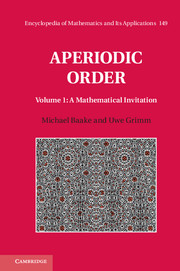Book contents
- Frontmatter
- Contents
- Foreword
- Preface
- Chapter 1 Introduction
- Chapter 2 Preliminaries
- Chapter 3 Lattices and Crystals
- Chapter 4 Symbolic Substitutions and Inflations
- Chapter 5 Patterns and Tilings
- Chapter 6 Inflation Tilings
- Chapter 7 Projection Method and Model Sets
- Chapter 8 Fourier Analysis and Measures
- Chapter 9 Diffraction
- Chapter 10 Beyond Model Sets
- Chapter 11 Random Structures
- Appendix A The Icosahedral Group
- Appendix B The Dynamical Spectrum
- References
- List of Examples
- List of Remarks
- Index
Chapter 10 - Beyond Model Sets
Published online by Cambridge University Press: 18 December 2014
- Frontmatter
- Contents
- Foreword
- Preface
- Chapter 1 Introduction
- Chapter 2 Preliminaries
- Chapter 3 Lattices and Crystals
- Chapter 4 Symbolic Substitutions and Inflations
- Chapter 5 Patterns and Tilings
- Chapter 6 Inflation Tilings
- Chapter 7 Projection Method and Model Sets
- Chapter 8 Fourier Analysis and Measures
- Chapter 9 Diffraction
- Chapter 10 Beyond Model Sets
- Chapter 11 Random Structures
- Appendix A The Icosahedral Group
- Appendix B The Dynamical Spectrum
- References
- List of Examples
- List of Remarks
- Index
Summary
The result on the pure point diffraction of crystallographic systems and. more generally, of regular model sets is constructive in the sense that it also provides a closed formula for the diffraction measure and the Fourier-Bohr coefficients (or amplitudes). Such a situation cannot be expected in general. and concrete results are rather sparse outside the realm of model sets. However, there are some notable exceptions. and it is the purpose of the following paragraphs to discuss several paradigms as concretely and explicitly as possible.
Another important line of generalisation concerns the difraction of subsets of model sets. We begin this part with a detailed treatment of lattice subsets. including the difraction of visible lattice points and related structures. and afterwards summarise some rather remarkable properties of general subsets of Meyer sets. Further examples will follow in Chapter 11.
Diffraction of the Thue-Morse chain
Let us consider the symmetric bi-infinite fixed point of the Thue-Morse substitution, as constructed in Section 4.6, in the realisation as a symmetric sequence w ∈{±1}ℤ. Recall that the (discrete) hull X(w) is uniquely ergodic under the ℤ-action of the shift. To continue, we follow the approach of [Kak72] and [AMF95, Part IV.4], and use the recursive definition of Eq. (4.14) together with Eq. (4.16) from Remark 4.8 on page 100; see also [BG08]. For the connection with difraction, we consider the signed (or weighted) Dirac comb ωTM = wδℤ with w as above.
- Type
- Chapter
- Information
- Aperiodic Order , pp. 397 - 430Publisher: Cambridge University PressPrint publication year: 2013

